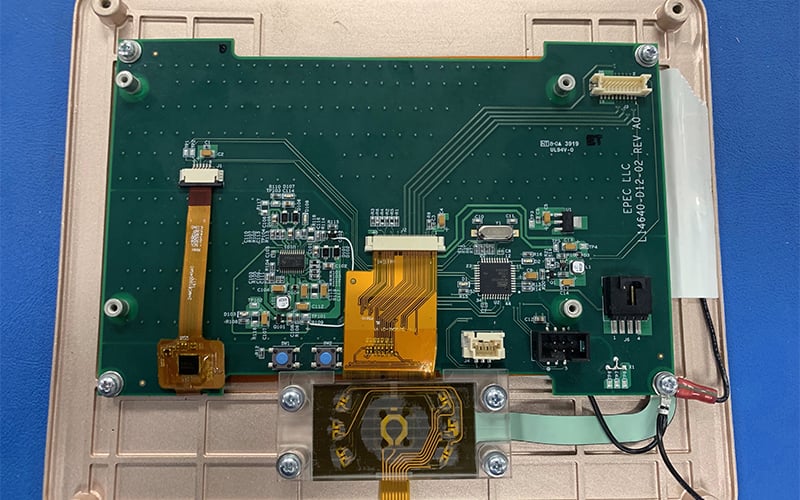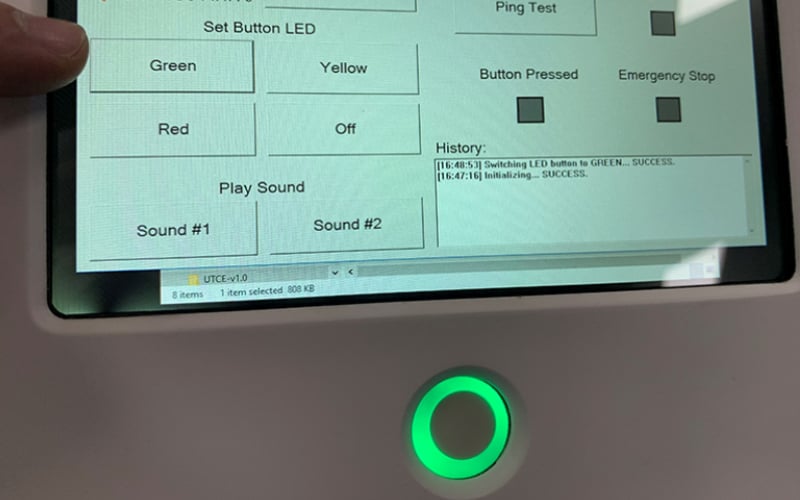It is not often we build an electronic device without any sort of prototyping, but it can happen given the nature of the project and the deadlines being met. If a customer needs a Human-Machine Interface (HMI) to hit the floor in 2 months, the time to develop and build a prototype is strained as both the customer and design engineers will want to test it and provide feedback.
Analysis will take time, as well as re-spinning changes into a new revision. If the changes were critical, another prototype may be required to prove the changes were effective. Depending on how much control is granted to the HMI, in terms of complexity and cost per unit, there is no way around prototyping as it would cost drastically more to rework printed circuit board assemblies (PCBAs) than to dish out the upfront cost of research and development (R&D) analysis in some cases.

Rear side of HMI with PCBA and flex circuits exposed.
Advantages of a Prototype
1. Verify the design works as intended
This is usually the most important part of prototyping, ensuring that the developed HMI meets the requirements of the customer and controls the LCD display or touchscreen as intended. In prototyping, it is common to consult with your customer so they can provide functional feedback as well, and often it is possible to add, remove, or modify some of the less critical features or requirements of the product.

HMI test procedure to indicate green LED button is working.
2. Ultimately save money by ensuring the performance is satisfactory for your customer
This is a big advantage that ties in to first advantage of prototyping. If the design team was not granted the award to develop a prototype, they may develop an HMI that functions to the customers requirements and can ship with confidence that it works to Epec’s standards. However, without a prototype and customer feedback, the product will not arrive for First Article Inspection with the customers recommendations. For example, do the buttons need to be larger because the operators must wear big bulky gloves and do those buttons require less force to press, etc. These issues can be addressed before reaching the quality department of the customer.
3. Discover which materials require a long-lead time
When we write up our bill of materials (BOM) to include the components used to build our product, it is uncommon to look up the lead time of each component, especially as some BOMs can be hundreds of components long.
Often times you can guess which products will have the longest lead time, such as an LCD display or a COM module, but sometimes it can be after the 12-week commitment to build and ship a product that it is discovered that the solid state relay has a 10-week lead time, leaving 2 weeks to complete the remainder of the build. When a prototype is built, all these components are ordered and any long-lead time parts are noticed immediately, ensuring that can be considered when committing to a deadline.
4. Determine complexities of assembly early-on
This is a big one. Often, an engineer will design the housings along with the user interface (UI) and circuit boards, and manufacturability is not accounted for because it is the last piece of the puzzle and fits just right. Prototyping really highlights these challenges early on because the engineer will get a good look at what they are asking the manufacturing team to build, and they will figure out whether a fixture or a jig is needed to make the UI assembly easier. The engineer can develop a set of work instructions during prototyping if they realize there is an easy or hard way to do something.
Disadvantages of a Prototype
1. Could require multiple revisions, using up a lot more time than intended
If a prototype does not cover the major requirements of the customer, a new revision or modifications to the existing prototype must be made. As this takes time, so does analysis, and depending on the complexities of the HMI, it could really take a long time. This will push back a deadline drastically; a very experienced or confident engineer can eliminate the need for some prototyping based off prior experience with the specified product.
2. Customer expectations may not be met
Sometimes the result of prototyping is not always good from a customer’s standpoint. Sometimes the major requirements are met, but the additional features your customer was excited about do not work as intended, such as audio volume control.
Another major disadvantage of prototyping is potentially throwing something together quickly, and your customer witnesses sloppy work. In personal experience, customers have used prototype materials that are only intended to provide a mechanical feel and used it for thermal testing. The quick turn-around Nylon did not survive thermal testing, as expected, and the customer was utterly disappointed.
On the opposite spectrum, failing to reach customer’s requirements during prototyping can sometimes be an advantage because it sets expectations early and optional features can be added/modified/removed given the success of the prototype.
3. Prevents team from exploring multiple different options if a prototype is necessary
Usually when an HMI prototype is decided upon, and the team begins building, other parallel paths to a solution are cut off, and the team focuses on the one solution. The team begins designing the overlay, UI, PCB, and housings all at once. This is also a risk of prototyping; not all options are explored if only one path is taken. This is especially true when the specific prototype takes lots of time or money to build.
4. High upfront cost for development and analysis
This is a big one for start-up or smaller companies especially, the upfront cost for a prototype usually covers the time to design, develop, and analyze the prototype all at the beginning of the program. On the opposite spectrum, the production pieces are usually invoiced after being approved through quality, usually around the time a customer can begin to make profit on the product.
Summary
While it is time-consuming and requires upfront costs, prototyping is highly recommended as it ultimately saves the customer money and provides more accurate timelines. It builds confidence in the product and often builds very good rapport between the engineering team and the customer. It is possible to manufacture HMIs without prototypes, but it puts both the engineering team and the customer at an elevated risk for failure, whether it be falling behind on timelines to modify resistor values on a voltage divider circuit or having to switch out covers because the molding was oversized by a separate supplier. The complexity of the HMI should be taken into account - prototyping pushes deadlines back, but that may ultimately save money.
Key Takeaways
- Prototyping verifies functionality: Building a prototype ensures the HMI performs as intended and gives customers a chance to provide early feedback on usability and features.
- Upfront cost saves long-term expense: Although prototypes require investment, they help uncover design issues, material lead times, and assembly challenges before costly production runs.
- Improves manufacturability: Prototypes reveal complexities in assembly, allowing engineers to refine work instructions, design fixtures, and streamline production processes.
- Risks include delays and added costs: Multiple revisions, unmet customer expectations, or focusing too narrowly on one solution can consume extra time and resources.
- Prototyping builds confidence and trust: Despite the disadvantages, prototypes strengthen customer relationships, provide clearer project timelines, and reduce the risk of expensive redesigns later.
















